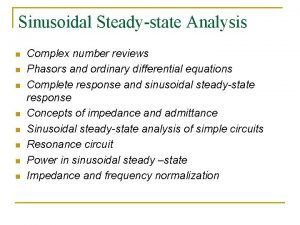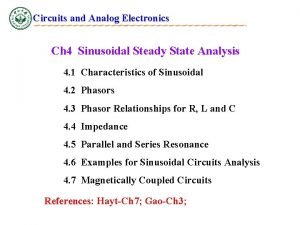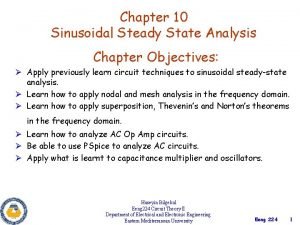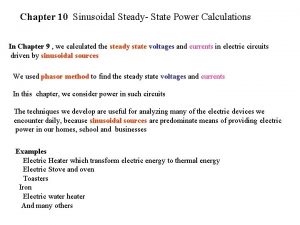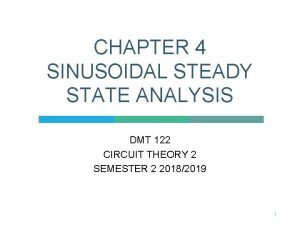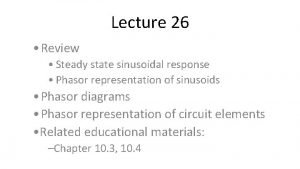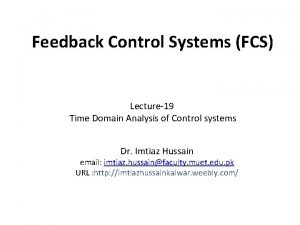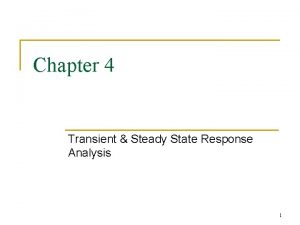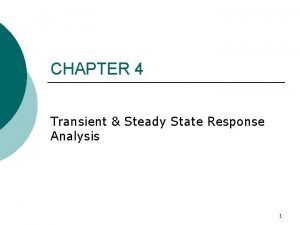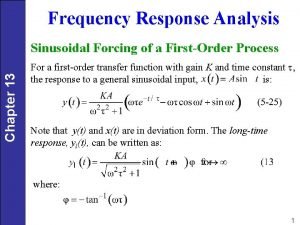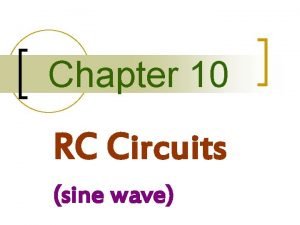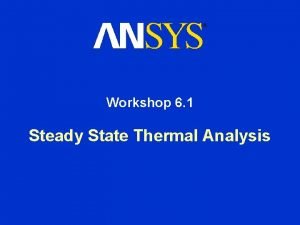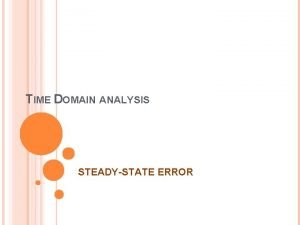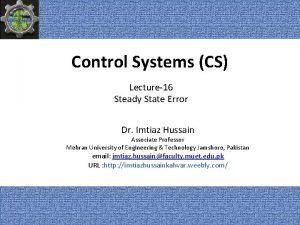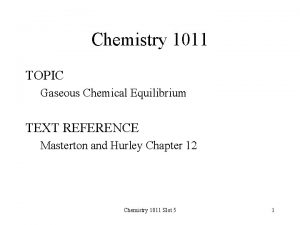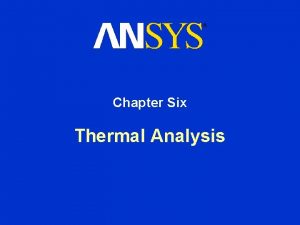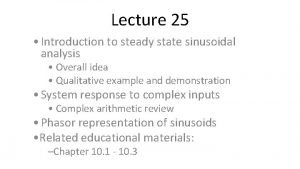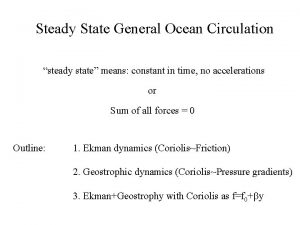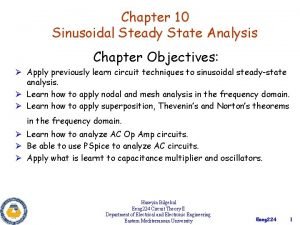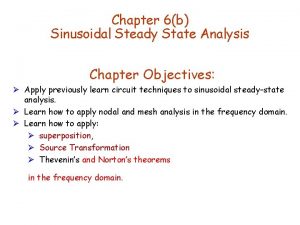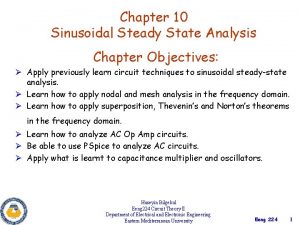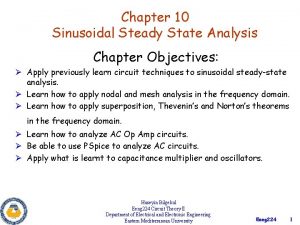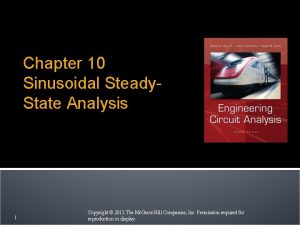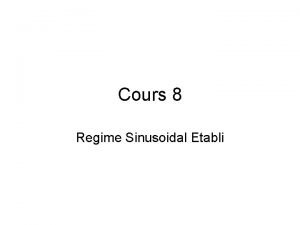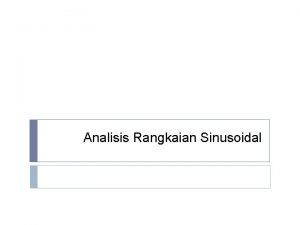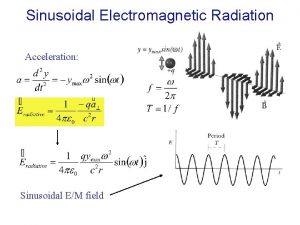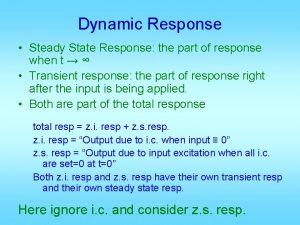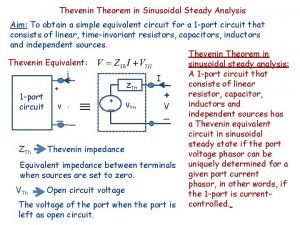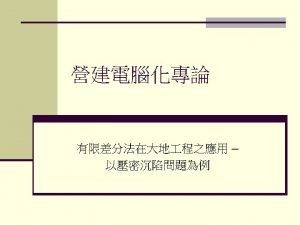Lecture 26 Review Steady state sinusoidal response Phasor






















- Slides: 22

Lecture 26 • Review • Steady state sinusoidal response • Phasor representation of sinusoids • Phasor diagrams • Phasor representation of circuit elements • Related educational materials: –Chapter 10. 3, 10. 4

Steady state sinusoidal response – overview • Sinusoidal input; we want the steady state response • Apply a conceptual input consisting of a complex exponential input with the same frequency, amplitude and phase • The actual input is the real part of the conceptual input • Determine the response to the conceptual input • The governing equations will become algebraic • The actual response is the real part of this response

Review lecture 25 example • Determine i(t), t , if Vs(t) = Vmcos(100 t). • Let Vs(t) be: • Phasor: • The phasor current is: • So that

Phasor Diagrams • Relationships between phasors are sometimes presented graphically • Called phasor diagrams • The phasors are represented by vectors in the complex plane • A “snapshot” of the relative phasor positions • For our example: • ,

Phasor Diagrams – notes • Phasor lengths on diagram generally not to scale • They may not even share the same units • Phasor lengths are generally labeled on the diagram • The phase difference between the phasors is labeled on the diagram

Phasors and time domain signals • The time-domain (sinusoidal) signals are completely described by the phasors • Our example from Lecture 25:

Example 1 – Circuit analysis using phasors • Use phasors to determine the steady state current i(t) in the circuit below if Vs(t) = 12 cos(120 t). Sketch a phasor diagram showing the source voltage and resulting current.

Example 1: governing equation

Example 1: Apply phasor signals to equation • Governing equation: • Input: • Output:


Example 1: Phasor diagram • Input voltage phasor: • Output current phasor:

Circuit element voltage-current relations • We have used phasor representations of signals in the circuit’s governing differential equation to obtain algebraic equations in the frequency domain • This process can be simplified: • Write phasor-domain voltage-current relations for circuit elements • Convert the overall circuit to the frequency domain • Write the governing algebraic equations directly in the frequency domain

Resistor i-v relations • Time domain: • Conversion to phasor: • Voltage-current relation:

Resistor phasor voltage-current relations • Phasor voltage-current relation for resistors: • Phasor diagram: • Note: voltage and current have same phase for resistor

Resistor voltage-current waveforms • Notes: Resistor current and voltage are in phase; lack of energy storage implies no phase shift

Inductor i-v relations • Time domain: • Conversion to phasor: • Voltage-current relation:

Inductor phasor voltage-current relations • Phasor voltage-current relation for inductors: • Phasor diagram: • Note: current lags voltage by 90 for inductors

Inductor voltage-current waveforms • Notes: Current and voltage are 90 out of phase; derivative associated with energy storage causes current to lag voltage

Capacitor i-v relations • Time domain: • Conversion to phasor: • Voltage-current relation:

Capacitor phasor voltage-current relations • Phasor voltage-current relation for capacitors: • Phasor diagram: • Note: voltage lags current by 90 for capacitors

Capacitor voltage-current waveforms • Notes: Current and voltage are 90 out of phase; derivative associated with energy storage causes voltage to lag current

 Sinusoidal steady state
Sinusoidal steady state Sinusoidal steady state analysis of coupled circuits
Sinusoidal steady state analysis of coupled circuits Sinusoidal steady state analysis solved problems
Sinusoidal steady state analysis solved problems Steady state current formula
Steady state current formula Sinusoidal steady state analysis
Sinusoidal steady state analysis Steady state sinusoidal analysis using phasors
Steady state sinusoidal analysis using phasors Cervicogram
Cervicogram Steady state response in control system
Steady state response in control system Hurtwitz
Hurtwitz Transient and steady state response analysis
Transient and steady state response analysis Sinusoidal response of first order system
Sinusoidal response of first order system Sinusoidal response of rc circuit
Sinusoidal response of rc circuit 01:640:244 lecture notes - lecture 15: plat, idah, farad
01:640:244 lecture notes - lecture 15: plat, idah, farad Steady state thermal analysis
Steady state thermal analysis In time domain analysis, finite steady state error is
In time domain analysis, finite steady state error is Pengangguran dan sifat alamiahnya
Pengangguran dan sifat alamiahnya Steady state kondition
Steady state kondition Nicole menten
Nicole menten What is a steady-flow process?
What is a steady-flow process? In a normal operations/steady state eoc activation level
In a normal operations/steady state eoc activation level What are static error constants
What are static error constants Steady state vs equilibrium
Steady state vs equilibrium What is steady-state thermal analysis?
What is steady-state thermal analysis?
